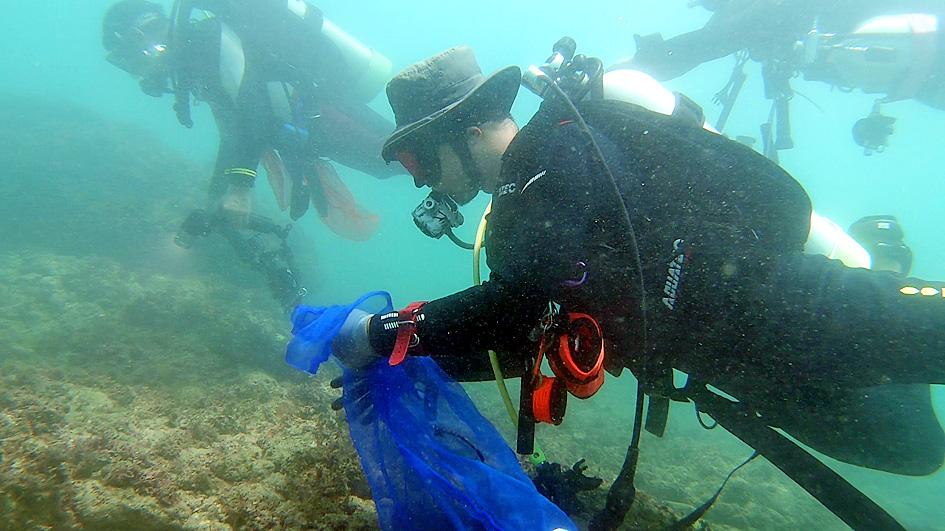New grant funded research into the sustainable protection of vulnerable coastal areas aims at using seagrasses for their boosts to biodiversity and wave dampening.
The presence of seagrass is decreasing worldwide due to poor water quality, plant diseases, climate change and coastal erosion. With the innovation project ‘PLANT ME’, the research team wants to enable the restoration of this ecosystem by developing a new planting technique for seagrass.
The research partners Ghent University, Jan De Nul Group, DEME Group and CCMAR combine their expertise as researchers and hydraulic engineers to boost the planet’s biodiversity. The partners also work together in the Coastbusters project, a research project on a nature-based type of coastal defence. This is where the ‘PLANT ME’ concept came into being, with its specific focus on protecting coastal strips by planting seagrass beds.
Worldwide, seagrass beds have been disappearing dramatically for decades and continue to do so as a result of poor water quality, plant diseases, climate change and coastal erosion. However, these seagrass beds are of great importance for shallow marine coastlines, because they provide a habitat for a high diversity of underwater fauna and flora and capture more CO2 than rainforests. In addition, seagrasses dampen waves to lose up to 75% of their strength, thus significantly reducing erosion.
With ‘PLANT ME’, the research partners want to enable the restoration of this precious coastal ecosystem by developing a new planting technique for seagrass. The great advantage of this method is that it is cheap to produce and that the used materials are biodegradable. With this new technique, new seagrass beds can be easily and quickly planted in shallow coastal ecosystems.
Emile Lemey, Project Development Engineer at Jan De Nul Group: “Seagrass is one of the most important breeding habitats in the sea, providing shelter for juvenile fish and securing the bottom it is growing in. Within PLANT ME Jan De Nul wants to contribute to saving this valuable marine ecosystem through researching novel grow-out and planting techniques.”
Tomas Sterckx, Project Manager at DEME: “As part of our sustainability efforts, DEME wants to build and revive marine, coastal, inland waterways and terrestrial ecosystems adding to a broad spectrum of nature-based solutions. This initiative fits perfectly with our own sustainability goals and we want to make full use of our expertise to support this innovative project.”
Riccardo Pieraccini, PhD student at Ghent University: “Seagrasses occur in every coastal zones on each continent, except Antarctica. Seagrass beds create unique habitats, supporting the biodiversity of coastal ecosystems, benefiting humans and animals. Seagrasses act as ecosystem engineers, stabilizing the seabed and reducing coastal erosion. The PLANT ME project has the ambitious mission of reverting the loss of seagrass ecosystems by creating an innovative, large-scale restoration technique based on natural biodegradable substrates overgrown with seagrass plants.”
Aschwin Engelen, researcher at CCMAR: “This project and its unique collaboration between science and industry to develop new large-scale applicable sustainable techniques for seagrass restoration will contribute strongly to the required future restoration of seagrass beds and coastal marine biodiversity.”
MAJOR CHALLENGES
Climate change and coastal erosion pose major challenges. ‘PLANT ME’ fits within a new research trend focusing on innovative solutions to protect coasts in a sustainable and efficient way. In the past, breakwaters and dikes were built, but in many cases they disrupted the natural supply of sand. Today, scientists are working on solutions that also involve nature, hence the term ‘nature-based solutions’. Elements provided by nature are used in an innovative, sustainable and resilient way to protect the same natural habitat. This does not only protect people, but also promotes services provided by nature such as biodiversity on the land-water boundary.
The ‘PLANT ME’ project is one of a series of projects that encourages industry to innovate and search for future-proof and sustainable solutions for a better world. The United Nations Sustainable Development Goals are a valuable reference framework for this. With ‘PLANT ME’, the research team contributes to a set of objectives that focuses on climate and biodiversity. Moreover, this project unites the academic and business worlds with the aim to achieve concrete results.
By Jake Frith
Source: Maritime Journal, Oct 13, 2020



